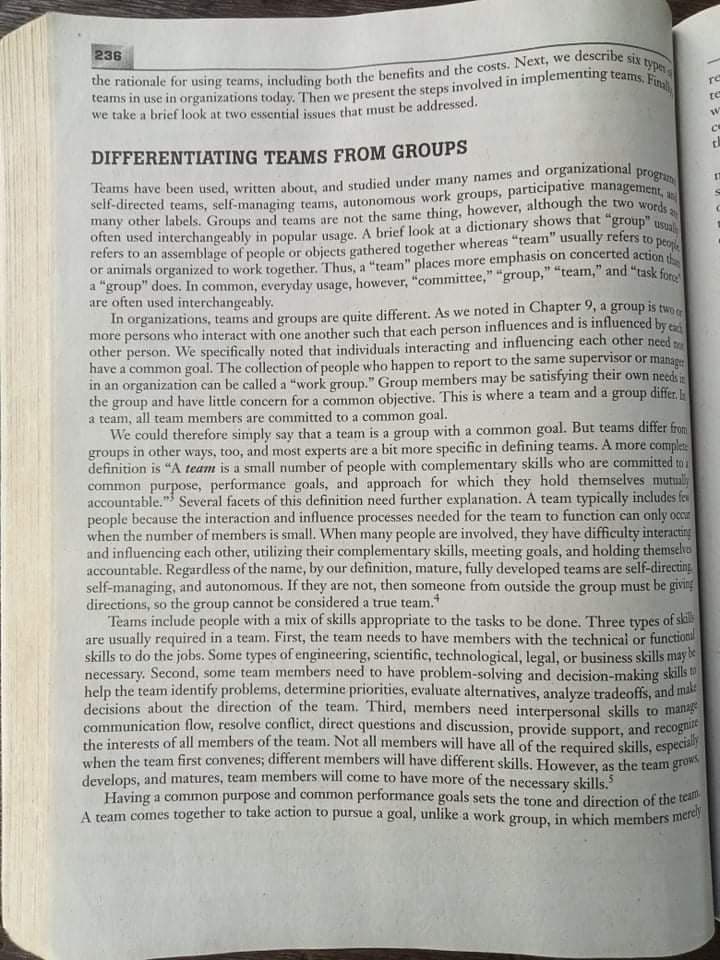Are groups the same with teams or not? How/Why did you say so?
Management, Loose-Leaf Version
13th Edition
ISBN:9781305969308
Author:Richard L. Daft
Publisher:Richard L. Daft
Chapter18: Leading Teams
Section: Chapter Questions
Problem 5DQ
Related questions
Question
Are groups the same with teams or not? How/Why did you say so?

Transcribed Image Text:refers to an assemblage of people or objects gathered together whereas "team" usually refers to peoi
the interests of all members of the team. Not all members will have all of the required skills, especialy
e describe six type
236
re
te
we take a brief look at two essential issues that must be addressed.
DIFFERENTIATING TEAMS FROM GROUPS
program
Teams have been used, written about, and studied under many names and organızational
many other labels. Groups and teams are not the same thing, however, althougn the two words
or animals organized to work together. Thus, a "team" places more emphasis on concerted action
a "group" does. In common, everyday usage, however, "committee," "group," "team," and "task foro
are often used interchangeably.
In organizations, teams and groups are quite different. As we noted in Chapter 9, a group is two
more persons who interact with one another such that each person influences and is influenced bye
other person. We specifically noted that individuals interacting and influencing each other need
have a common goal. The collection of people who happen to report to the same supervisor or manage
in an organization can be called a "work group." Group members may be satisfying their own needs
the group and have little concern for a common objective. This is where a team and a group differ,
a team, all team members are committed to a common goal.
We could therefore simply say that a team is a group with a common goal. But teams differ from
groups in other ways, too, and most experts are a bit more specific in defining teams. A more complet
definition is "A team is a small number of people with complementary skills who are committed to a
common purpose, performance goals, and approach for which they hold themselves mutuly
accountable." Several facets of this definition need further explanation. A team typically includes fev
people because the interaction and influence processes needed for the team to function can only occu
when the number of members is small. When many people are involved, they have difficulty interacting
and influencing each other, utilizing their complementary skills, meeting goals, and holding themselve
accountable. Regardless of the name, by our definition, mature, fully developed teams are self-directing
self-managing, and autonomous. If they are not, then someone from outside the group must be giving
directions, so the group cannot be considered a true team.
Teams include pcople with a mix of skills appropriate to the tasks to be done. Three types of skil
are usually required in a team. First, the team needs to have members with the technical or functionil
skills to do the jobs. Some types of engineering, scientific, technological, legal, or business skills may e
necessary. Second, some team members need to have problem-solving and decision-making skills t
help the team identify problems, determine priorities, evaluate alternatives, analyze tradeoffs, and mai
decisions about the direction of the team. Third, members need interpersonal skills to manag
communication flow, resolve conflict, direct questions and discussion, provide support, and recogni
when the team first convenes; different members will have different skills. However, as the team grow
develops, and matures, team members will come to have more of the necessary skills.
Having a common purpose and common performance goals sets the tone and direction of the tean
A team comes together to take action to pursue a goal, unlike a work group, in which members mere
Expert Solution
This question has been solved!
Explore an expertly crafted, step-by-step solution for a thorough understanding of key concepts.
Step by step
Solved in 3 steps with 1 images

Recommended textbooks for you

Management, Loose-Leaf Version
Management
ISBN:
9781305969308
Author:
Richard L. Daft
Publisher:
South-Western College Pub

Management, Loose-Leaf Version
Management
ISBN:
9781305969308
Author:
Richard L. Daft
Publisher:
South-Western College Pub